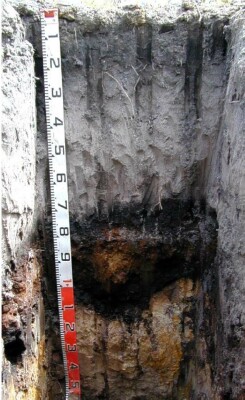HUN99 (Plot 3)
| HUN99 (Plot 3) | Land Unit: Strathdownie |
| Aust. Soil Class.: | |
 |
This land unit comprises the Quaternary lacustrine geology south of the Glenelg River. The lacustrine deposits include lagoonal, swamp and local colluvial deposits formed in low-lying wetlands and depressions between stranded beach ridges. Parent material in this land unit comprises of sand, silt, sandy clay, peat, marl and freshwater limestone, occurring in relatively unconsolidated forms. The soils are variable throughout this land unit due to varying depositional environments. A common soil type is a strong texture contrast soil (Chromosol, Sodosol) commonly with a bleached A2 horizon and a mottled subsoil (indicative of impeded internal drainage). The sandy topsoil can be very deep in some soils. Vertosols are also common on the plains and swales in between the dunes. Podosols occur on the flats as well as on the dunes and that may have been mapped as part of this land unit due to restrictions of scale. Many of the soils are poorly drained and exhibit signs of a perched watertable. 1.5 year old Eucalyptus globulus plantation on ex-agricultural land. Free water at 150 cm and at 300 cm. The density of limestone at 300 cm suggests that there may be an impeding layer to root growth at this depth, but some data from Forestry SA indicates that the presence of shallow limestone may not necessarily restrict root development. |
Site Description:
| Geology: Quaternary lacustrine | Landform pattern: Gently undulating plain |
| Position in landscape: Lower slope | Internal drainage: Imperfectly drained |
| A1 | 0-20 cm | Very dark grey (10YR3/1) loamy fine sand; single grain structure; loose consistence when moderately moist; many medium roots; clear and smooth transition to: |  |
| A2 | 20-70 cm | Greyish brown (10YR5/2) fine sand; single grain structure; loose consistence when moist; common very fine roots; abrupt and smooth transition to: | |
| Subsoil | |||
| Bh | 70-80 cm | Black (10YR2/1) loamy fine sand; single grain structure; loose consistence when moist; many very fine roots; abrupt and smooth transition to: | |
| Bs | 80-100 cm | Very dark brown (10YR2/2) with many coarse distinct strong brown (7.5YR5/6) mottles, loamy fine sand; massive structure; strong consistence when moderately moist; moderately cemented continuous massive organic pan; unable to assess macroporosity due to structure; no roots observed; abrupt and wavy transition to: | |
| B2 | 100-115 cm | Very pale brown (10YR7/3) with common fine dark yellowish brown (10YR4/4) and reddish yellow (7.5YR6/8) mottles, fine sandy clay; weak angular blocky structure (20-50 mm); very weak consistence when wet; few very fine macropores; areal porosity 0.1%; few very fine roots; clear and wavy transition to: | |
| B3 | 115-150 cm | Very pale brown (10YR7/3) with common fine distinct reddish yellow (7.5YR6/8) mottles, clayey fine sand; single grain structure; loose consistence when wet; unable to assess macroporosity due to structure; no roots observed. | |
| 150-200 cm | Sand. | ||
| 200-250 cm | Sand with soft limestone (CaCO3) and limestone nodules. | ||
| 250-300 cm | Sand, more limestone with depth, becoming very hard and impenetrable at 300 cm. |


